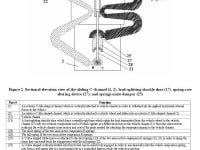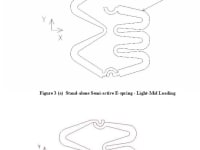
The key challenge in designing vehicle suspension springs is primarily to cost-effectively strike a balance between vehicle ride comfort, road holding, and load carrying capacity. A Hybrid micro-composite E-like shaped spring strikes such a balance cost-effectively. Its advantages include
(1) Light weight:
For instance, the E-spring weighs 25% less in comparison with the traditional semi-elliptic multi-leaf spring, which implies fuel consumption economy improvement;
(2) Compact rattle space requirements:
For instance, the E-spring saves almost 75% of the rattle space required by the semi-elliptic multi-leaf springs;
(3) Less costly:
For instance, the E-spring saves almost 25% of the aggregate cost associated with each of the other types of suspension springs:
(4) Reduced cost of the parts that connect the suspension spring with the vehicle chassis: This is due to the need for only one shackle shoe rather than two such as the case of the semi-elliptic multi-leaf spring;
(5) Reduced vehicle chassis cross section:
This is due to splitting the transmitted vertical external load to the vehicle chassis into two components using the E-spring’s shackle shoe of mid split base;
(6) Naturally provides non-linear spring rate:
Due to the unequal air gaps between the turns of the E-shape, providing full springing with rising rate stiffness and partial damping, unlike the conventional torsion bar springs;
(7) Naturally strikes a balance between maximizing deflection capability and minimizing induced stress:
For the same maximum induced stress level, the E-spring can have deflection capacity of 25% more than that of the traditional semi-elliptic multi-leaf spring.
(8) Improved structural material:
The commercially used structural material of the semi-elliptic multi-leaf spring is AISI 9255 alloy steel which has tensile strength of 775MPa; the hybrid micro-composite E-spring of polyester resin with mineral clay powder proved to have longitudinal compressive strength of 1518 MPa, longitudinal tensile strength of almost 2530 MPa, and transversal compressive strength of 1260 MPa;
(9) Semi-active suspension system of very compact rattle space requirements:
(10) Fully-proof against all longitudinal and lateral horizontal external forces:
Using a sliding C-channel mechanism that can be attached to the E-spring;
(11) Achievable spring rate within the same compact rattle space allowance:
By increasing or decreasing the number of turns of the E-spring, using semi-active configuration, using a U-like shaped vertically slotted solid block the spring rate can be adjusted within the same compact rattle space allowance;
(12) Superlative transmissibility ratio:
The hybrid micro-composite E-spring provides low transmissibility ratio and consequently improves vibration isolation;
(13) Improved fatigue life:
This is due to the following reasons:
(a) The continuum structure of the E-spring; (b) Almost constant induced stress throughout the developed length of the E-spring due to its optimized graduated thickness;
(14) More reliable in the long run, in comparison with the other types of springs:
This is due to the fact that the E-spring is less complicated.
(15) Fast response to sudden maneuver:
This technology suits the vans, cross-over vehicles, light and heavy commercial vehicles market segments which represent 25% of the global market sales volume.
-
Awards
-
 2013 Top 100 Entries
2013 Top 100 Entries
Like this entry?
-
About the Entrant
- Name:Salah Elmaghazy
- Type of entry:individual
- Patent status:patented








